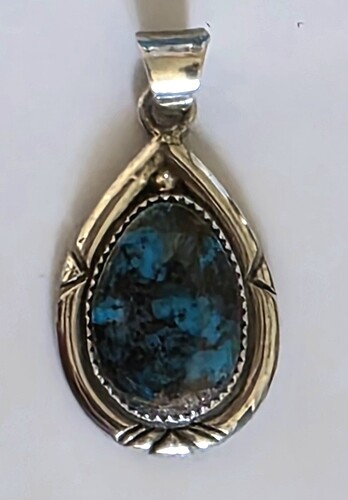I imagine there was a time when Bisbee was a lot more common when the mine was still open and people were allowed access to the dumps, but at what point did Bisbee become “rare?” Was there ever a time when it was ubiquitous like other kinds of turquoise?
Bisbee has always been an uncommon turquoise. It’s my understanding only about 2,000 lbs were ever taken from the mine. For example, compare that to the Kingman mine. I read that in 1973 alone, Kingman produced 80,000 lbs of turquoise. That is partly why many of us here are hesitant to call turquoise Bisbee, and also why so many people claim their turquoise is Bisbee since it is more rare. Here are a couple good links on the history.
https://www.durangosilver.com/bisbee-turquoise.html
My brother-in-law lives in the UP (Upper Peninsula) of Michigan in an area that in the 1800s had a huge copper mining industry (biggest in the world at that time I believe). Once while visiting him we checked out the local mining museum. It was interesting to learn that part of what shut down the industry in northern Michigan were the big open pit copper mines in AZ, such as the Bisbee mine. The mines in the UP were having to have deeper and deeper shafts dug, so the open pit mines in Arizona sealed their fate. The museum had some specimens of the malachite and turquoise that were found in the Bisbee mine. I believe the Lavender Pit is the section of the mine where they found the turquoise.
Zia has it right. Some rare turquoise was always rare, even when discovered. The “hat” mines are other examples.
I never knew anything about Bisbee turquoise when I inherited my mom’s buckle. We just both thought it was a really pretty stone. When it became loose I almost kept wearing it risking it falling out, but then decided I better have it fixed. When the lady I sent it to in ABQ called me to tell me what she believed it was, I was glad I had stopped wearing it. I don’t have provenance on the mine, but she was pretty sure, and it does look like it. I’m surprised my dad didn’t have the receipt, since he kept info for stuff like that. My brother found all the old receipts from our trip west in '69 (even the letters my dad sent to the hotels to reserve rooms!), and they’re in his basement. I think I’m going to eventually dig through it to see if I can find any paperwork on the buckle and the stone.
You can google the Bisbee Mine in Bisbee Arizona and find lots of information. Mining copper was the purpose of the mine. Much like the Morenci mine also in Arizona. Companies are mining metals at a rate per ton and have scaled their mines for this. Pretty turquoise found by the workers tends to be looked at as a distraction, and sometimes as a safety concern. I have heard rumours that the Morenci mine dumped tons of material on top of where they were finding Morenci turquoise to keep the workers out of it.
A couple of hundred pounds of turquoise to a mining operations that produces169.45 million metric tons per annum of copper is peanuts. You can still visit the mine in Bisbee, they run tours I believe.
Yes, it’s called the Queen Mine Tour. I was there a couple of years ago and looks like a great experience. Unfortunately, I didn’t have time to take the tour, but did have time to enjoy their little gift shop and came home with a beautiful Bisbee turquoise pendant crafted by a local artist. I look forward to going back someday, taking the tour, and picking up more special pieces for my collection.
What a gorgeous stone!
Thank you! It was more than I really should have spent that day, but I haven’t regretted it for a moment. It’s my favorite piece and I wear it frequently.
@Emily sorry if I offended. I was excited to share what I now understand is common knowledge among this forum. My apologies.
You asked if it was ever as ubiquitous as other forms of turquoise, which it was not. It is my understanding that once people saw how beautiful Bisbee turquoise was, it pretty quickly became a hot commodity, and it has always been rare.
I’ve had people on here explain to me things that I already knew, and I never considered them as being condescending. We were truly trying to be helpful. Your question was rather unclear.
As stated in earlier posts, there was never a time when supply was ample. The best Bisbee was quickly recognized and priced as such.
Here’s an enlightening take on “value” in turquoise that mentions Bisbee’s different pricing by quality–a reminder that not all Bisbee is or was top dollar.
https://www.turquoiseinamerica.com/post/the-value-of-turquoise
